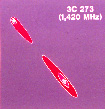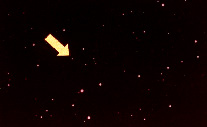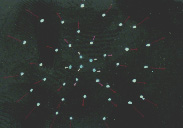
So now, let's move out billions of light years and see if we find any new inhabitants of the universe. In fact, we do! At a distance of between 8 and 12 billions light years, we find a large population of objects called quasars. These objects were first discovered in 1963 as stars that appeared to be emitting radio waves ("quasi-stellar radio sources," or "quasars" for short). The current thought is that quasars are the active nuclei of very distant (and fairly young) galaxies. It is theorized that there are giant black holes at the centers of these galaxies. As matter falls into these black holes, it emits tremendous amounts of energy which makes quasars visible over half way across the universe. In the constellation Virgo is 3C 273. Through a telescope, 3C 273 appears simply as an ordinary star. It is a better view if we look at it in the radio part of the spectrum.


So what happens if we look farther and farther away? At a distance of about 15 billion light years we see a wall of light that was emitted shortly after the big bang. And what other evidence is there of the big bang? In fact, all of the objects we have mentioned that lie beyond our local group of galaxies are rushing away from us at a rate proportional to their distance. It is fairly easy to determine these recessional velocities and therefore it's easy to estimate distances (although there is a good bit of uncertainty in these estimates).
We might interprete the big bang as something like this.

Go to next section.
Return to "Planetarium Shows This Semester"